新版pep六年级上期末复习
- 格式:doc
- 大小:43.50 KB
- 文档页数:3
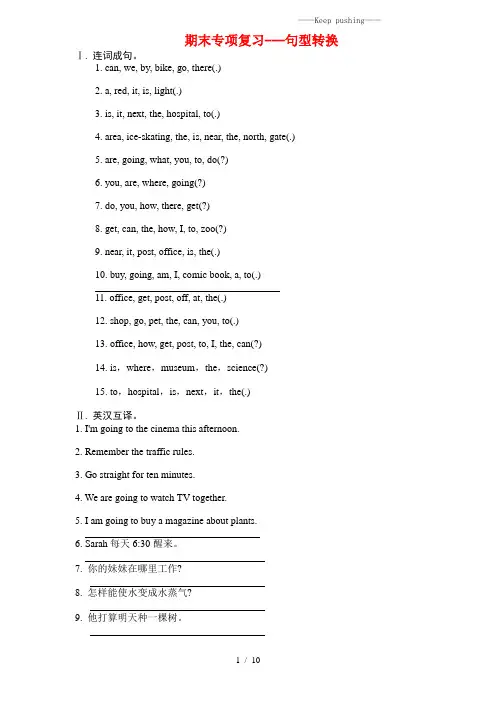
期末专项复习---句型转换Ⅰ.连词成句。
1. can, we, by, bike, go, there(.)____________________________________2. a, red, it, is, light(.)____________________________________3. is, it, next, the, hospital, to(.)____________________________________4. area, ice-skating, the, is, near, the, north, gate(.)___________________________________5. are, going, what, you, to, do(?)____________________________________6. you, are, where, going(?)____________________________________7. do, you, how, there, get(?)____________________________________8. get, can, the, how, I, to, zoo(?)____________________________________9. near, it, post, office, is, the(.)____________________________________10. buy, going, am, I, comic book, a, to(.)11. office, get, post, off, at, the(.)____________________________________12. shop, go, pet, the, can, you, to(.)____________________________________13. office, how, get, post, to, I, the, can(?)____________________________________14. is,where,museum,the,science(?)____________________________________15. to,hospital,is,next,it,the(.)____________________________________Ⅱ. 英汉互译。
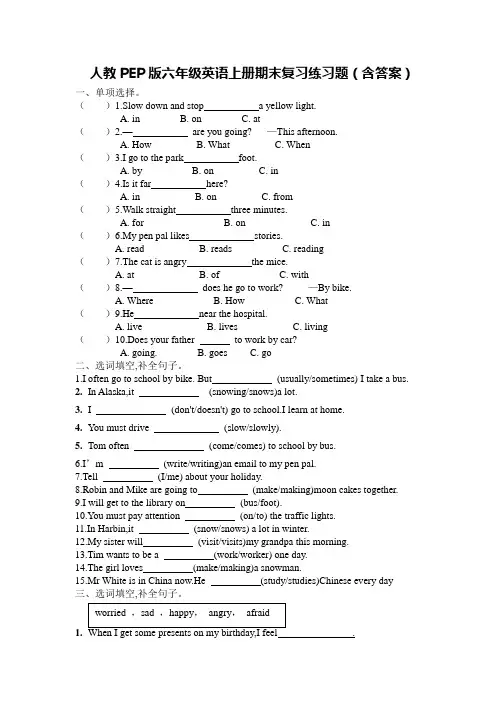
人教PEP版六年级英语上册期末复习练习题(含答案)一、单项选择。
()1.Slow down and stop a yellow light.A. inB. onC. at()2.—are you going? —This afternoon.A. HowB. WhatC. When()3.I go to the park foot.A. byB. onC. in()4.Is it far here?A. inB. onC. from()5.Walk straight three minutes.A. forB. onC. in()6.My pen pal likes stories.A. readB. readsC. reading()7.The cat is angry the mice.A. atB. ofC. with()8.—does he go to work? —By bike.A. WhereB. HowC. What()9.He near the hospital.A. liveB. livesC. living()10.Does your father to work by car?A. going.B. goesC. go二、选词填空,补全句子。
1.I often go to school by bike. But (usually/sometimes) I take a bus.2.In Alaska,it (snowing/snows)a lot.3.I (don't/doesn't) go to school.I learn at home.4.You must drive (slow/slowly).5.Tom often (come/comes) to school by bus.6.I’m (write/writing)an email to my pen pal.7.Tell (I/me) about your holiday.8.Robin and Mike are going to (make/making)moon cakes together.9.I will get to the library on (bus/foot).10.You must pay attention (on/to) the traffic lights.11.In Harbin,it (snow/snows) a lot in winter.12.My sister will (visit/visits)my grandpa this morning.13.Tim wants to be a (work/worker) one day.14.The girl loves (make/making)a snowman.15.Mr White is in China now.He (study/studies)Chinese every day三、选词填空,补全句子。
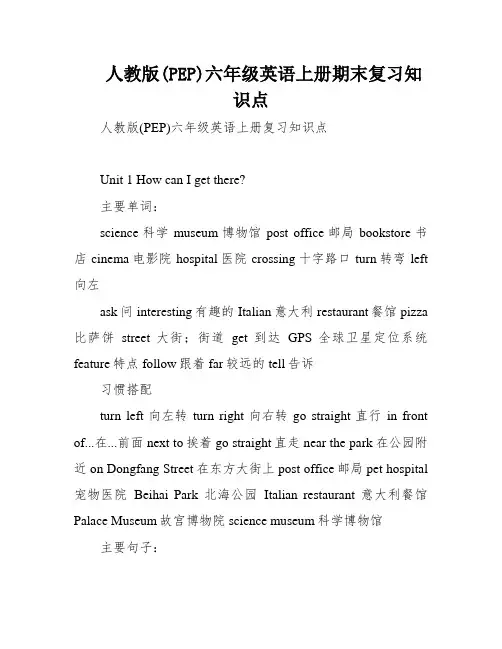
人教版(PEP)六年级英语上册期末复习知识点人教版(PEP)六年级英语上册复习知识点Unit 1 How can I get there?主要单词:science科学museum博物馆post office邮局bookstore书店cinema电影院hospital医院crossing十字路口turn转弯left 向左ask问interesting有趣的Italian意大利restaurant餐馆pizza 比萨饼street大街;街道get到达GPS全球卫星定位系统feature特点follow跟着far较远的tell告诉习惯搭配turn left向左转turn right向右转go straight直行in front of...在...前面next to挨着go straight直走near the park在公园附近on Dongfang Street在东方大街上post office邮局pet hospital 宠物医院Beihai Park北海公园Italian restaurant意大利餐馆Palace Museum故宫博物院science museum科学博物馆主要句子:☆1、☆Where is the museum shop?博物馆的市肆在哪儿?☆☆2、It’s near the door.在大门附近。
☆☆3、How can we get there?我们怎么到那儿?☆☆4、Turn left at the bookstore.在书店左转。
☆5、I want to buy a postcard.我想买一张明片。
6、I’ll ask.我去问问。
7、Wow, a talking robot!哇!一个讲话机器人。
8、What a great museum!好棒的一家博物馆!10、There is a pet hospital in my city.在我的城市有一家宠物医院。
11、Wu Yifan and Robin are looking at some robots.吴一凡和罗宾正在看一些机器人。
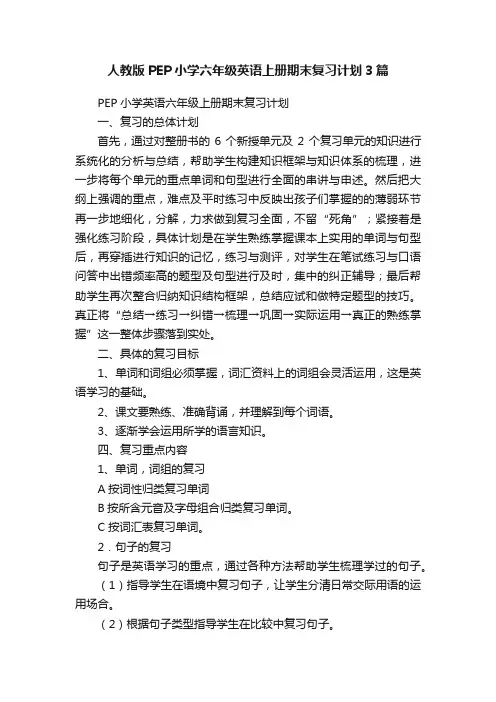
人教版PEP小学六年级英语上册期末复习计划3篇PEP小学英语六年级上册期末复习计划一、复习的总体计划首先,通过对整册书的6个新授单元及2个复习单元的知识进行系统化的分析与总结,帮助学生构建知识框架与知识体系的梳理,进一步将每个单元的重点单词和句型进行全面的串讲与申述。
然后把大纲上强调的重点,难点及平时练习中反映出孩子们掌握的的薄弱环节再一步地细化,分解,力求做到复习全面,不留“死角”;紧接着是强化练习阶段,具体计划是在学生熟练掌握课本上实用的单词与句型后,再穿插进行知识的记忆,练习与测评,对学生在笔试练习与口语问答中出错频率高的题型及句型进行及时,集中的纠正辅导;最后帮助学生再次整合归纳知识结构框架,总结应试和做特定题型的技巧。
真正将“总结→练习→纠错→梳理→巩固→实际运用→真正的熟练掌握”这一整体步骤落到实处。
二、具体的复习目标1、单词和词组必须掌握,词汇资料上的词组会灵活运用,这是英语学习的基础。
2、课文要熟练、准确背诵,并理解到每个词语。
3、逐渐学会运用所学的语言知识。
四、复习重点内容1、单词,词组的复习A按词性归类复习单词B按所含元音及字母组合归类复习单词。
C 按词汇表复习单词。
2.句子的复习句子是英语学习的重点,通过各种方法帮助学生梳理学过的句子。
(1)指导学生在语境中复习句子,让学生分清日常交际用语的运用场合。
(2)根据句子类型指导学生在比较中复习句子。
(3)指导学生在表演中运用句子,使复习课同样生动有趣。
3、课文的复习。
(1) 学生能够正确拼写let’s learn课后单词(2) 学生能够正确、流利地认读let’s talk课文(3) Read and Write中的重点句学生能够达到四会(即听、说、读、写)4、音标的复习。
学生能够认读所学字母组合及辅音字母在单词中的发音,并掌握其规律。
5、指导学生阅读短文,并培养其阅读技巧和方法。
6、书面表达的复习:针对每一单元的重难点及话题进行循序渐进的操练。
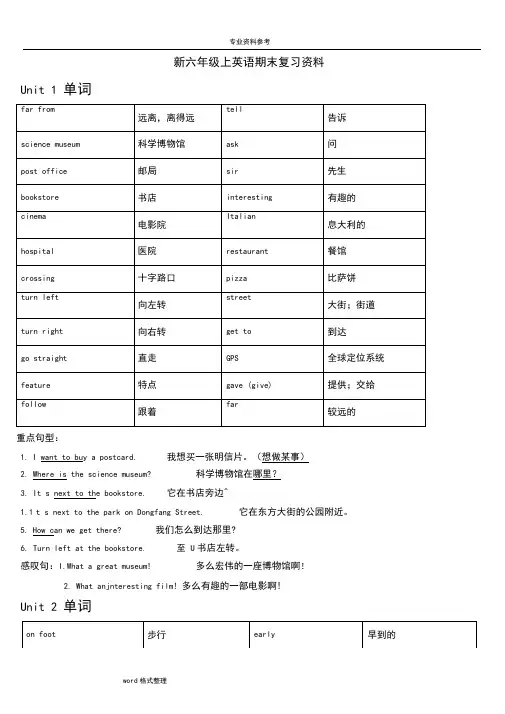
新六年级上英语期末复习资料Unit 1 单词重点句型:1.I want to buy a postcard. 我想买一张明信片。
(想做某事)2.Where is the science museum? 科学博物馆在哪里?3.It s next to the bookstore. 它在书店旁边^1.1t s next to the park on Dongfang Street. 它在东方大街的公园附近。
5.How can we get there? 我们怎么到达那里?6.Turn left at the bookstore. 至U书店左转。
感叹句:I.What a great museum! 多么宏伟的一座博物馆啊!2.What anjnteresting film! 多么有趣的一部电影啊!Unit 2 单词重点句型:1.How do you come to school? 你怎么来的学校?(go to school 去学校)2.I come to school by bike. 我骑自行车来的学校。
3.How does he go...to...school? 他怎么去的学校?4.He goes to school on foot. 他步行去学校。
5.—How do you get to the USA from China? 你怎么丛中国到美国?一By plane. 乘飞机。
6.Take the No.57 bus over there. 乘那里的57 路公交车。
7.I must. pay attention to the traffic lights. 我必须要注意交通信号灯。
8.The park is over there. 公园就在那里。
9. In the USA people on bikes must wear the helmet. 在美国人们骑自行车必须戴头盔。
10.Don 't go at the red light! 红灯时禁止通行!11.You must look right before you cross the road. 穿过马路时你必须向右看。
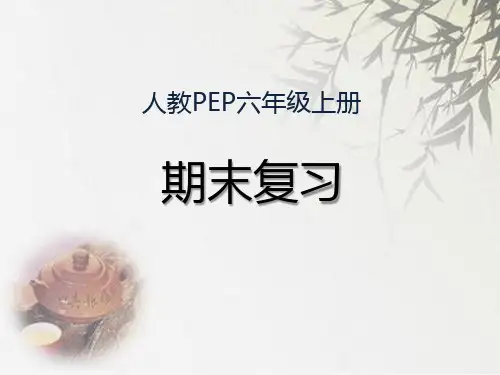
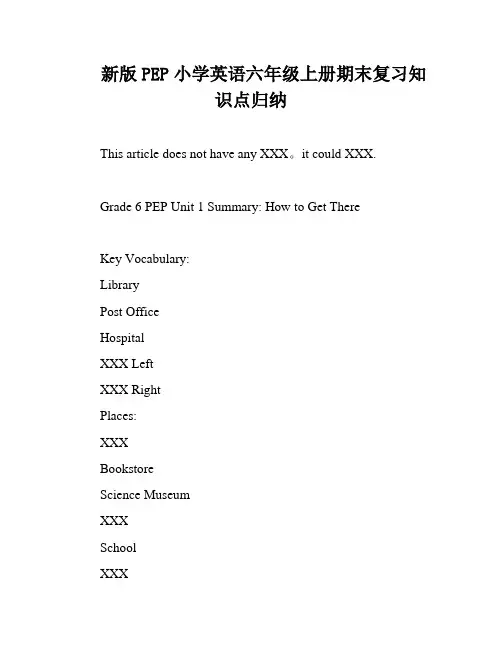
新版PEP小学英语六年级上册期末复习知识点归纳This article does not have any XXX。
it could XXX.Grade 6 PEP Unit 1 Summary: How to Get ThereKey Vocabulary:LibraryPost OfficeHospitalXXX LeftXXX RightPlaces:XXXBookstoreScience MuseumXXXSchoolXXXCrossingShoe StoreXXXKey Phrases for Asking ns:1."Where is the cinema。
please?" - Next to the bookstore。
in front of the school。
behind the park。
near the zoo。
on Dongfang Street。
over there.2."Excuse me。
is there a cinema near here?" - Yes。
there is。
/ No。
there isn't.3."How can I get to the hospital?" - Turn right/left at the。
go straight。
or take the No.31 bus.4."Is it far from here?" - Yes。
it is。
/ No。
it isn't.Grade 6 PEP Unit 2 Summary: Ways to Go to SchoolKey Vocabulary:XXXBySlow DownBusFootXXX.Traffic ToolsWhen it XXX。
there are us ns available。
The train is a popular choice for long-distance travel。
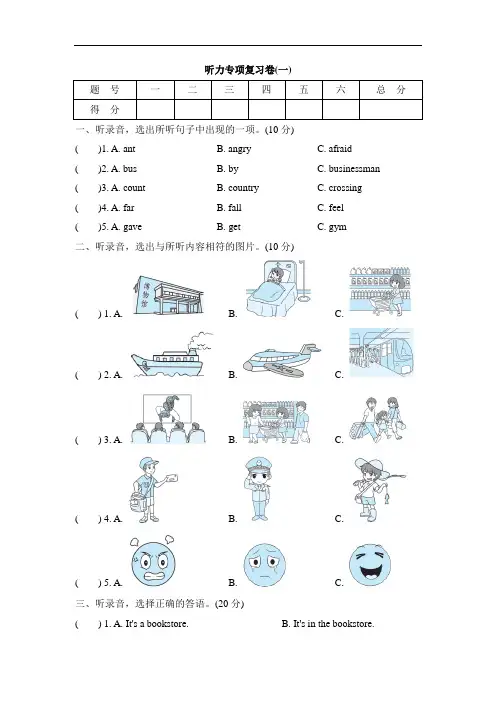
听力专项复习卷(一)题号一二三四五六总分得分一、听录音,选出所听句子中出现的一项。
(10分)()1. A. ant B. angry C. afraid()2. A. bus B. by C. businessman()3. A. count B. country C. crossing()4. A. far B. fall C. feel()5. A. gave B. get C. gym二、听录音,选出与所听内容相符的图片。
(10分)() 1. A. B. C.() 2. A. B. C.() 3. A. B. C.() 4. A. B. C.() 5. A. B. C.三、听录音,选择正确的答语。
(20分)() 1. A. It's a bookstore. B. It's in the bookstore.C. It's in front of the museum.() 2. A. I usually come to school at 7:30. B. I live near school.C. I often come to school on foot.() 3. A. I'm going to have a music lesson. B. I like drawing pictures.C. I don't like the park.() 4. A. He likes reading books. B. She likes going hiking.C. He is going to sing a song.() 5. A. Yes, he does. B. Yes, he is. C. Yes, we are. 四、听对话,根据对话内容判断以下内容正误,正确写T,错误写F。
(20分) () 1. Amy often goes to school by bus.() 2. Linda is going to buy a comic book this afternoon.() 3. Amy's uncle studies Chinese in Beijing.() 4. Sam's grandfather works in a big factory.() 5. Peter's brother was ill, but he feels well now.五、听短文,连线。
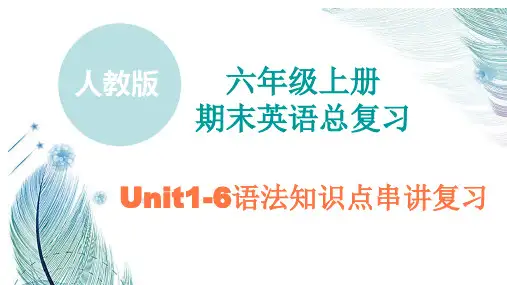
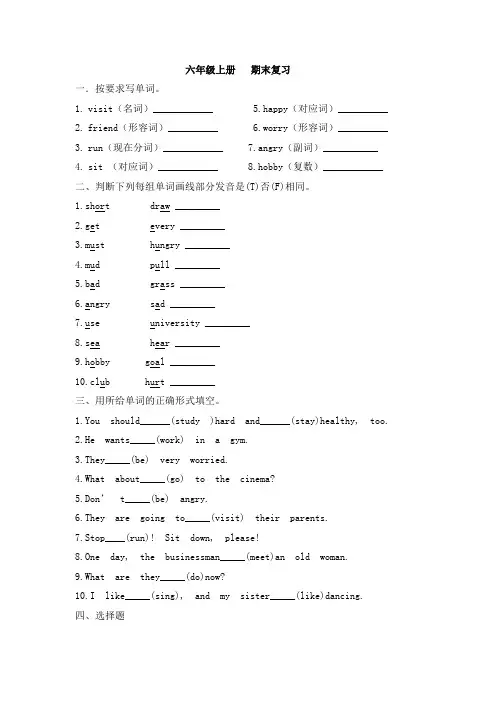
六年级上册期末复习一.按要求写单词。
1.visit(名词)____________ 5.happy(对应词)__________2.friend(形容词)__________ 6.worry(形容词)__________3.run(现在分词)____________ 7.angry(副词)___________4.sit (对应词)____________ 8.hobby(复数)____________二、判断下列每组单词画线部分发音是(T)否(F)相同。
1.short draw _________2.get every _________3.must hungry _________4.mud pull _________5.bad grass _________6.angry sad _________e university _________8.sea hear _________9.hobby goal _________10.club hurt _________三、用所给单词的正确形式填空。
1.You should______(study )hard and______(stay)healthy, too.2.He wants_____(work) in a gym.3.They_____(be) very worried.4.What about_____(go) to the cinema?5.Don’t_____(be) angry.6.They are going to_____(visit) their parents.7.Stop____(run)! Sit down, please!8.One day, the businessman_____(meet)an old woman.9.What are they_____(do)now?10.I like_____(sing), and my sister_____(like)dancing.四、选择题( )1. I have a headache. I am going to the _________.A.parkB. hospitalC. school( )2. Look! ______are reading ________comic books.A.They, theyB. They, theirC. Their, they( )3. What’s that? ________ a helmet.A.That’sB. It’sC. This is( )4. Those books _____________mine.A.are different toB. are different fromC. is different from ( )5. I want a science teacher one day.A.toB.to beC.to do( )6. In England, drivers drive on the _____ side.A.leftB. rightC. middle( )7. You can turn right _____ the second traffic lights.A.forB. onC. at( )8. The museum is _______ Dongfang Street.A.onB. inC.at( )9. He can ______ the boys ________ the Italian restaurant. A.helps, finds B. help, finds C. help, find( )10.Don't be _______. You should take a deep breath.A..happyB.sadC.angry五、根据汉语意思补充句子。
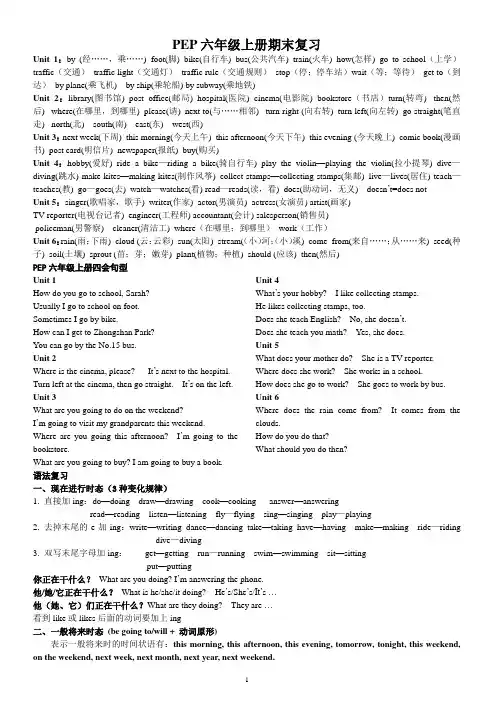
PEP六年级上册期末复习Unit 1:by (经……,乘……) foot(脚) bike(自行车) bus(公共汽车) train(火车) how(怎样) go to school(上学)traffic(交通) traffic light(交通灯) traffic rule(交通规则)stop(停;停车站)wait(等;等待)get to(到达)by plane(乘飞机) by ship(乘轮船) by subway(乘地铁)Unit 2:library(图书馆) post office(邮局) hospital(医院) cinema(电影院) bookstore(书店)turn(转弯) then(然后) where(在哪里,到哪里) please(请) next to(与……相邻) turn right (向右转) turn left(向左转) go straight(笔直走) north(北) south(南) east(东) west(西)Unit 3:next week(下周) this morning(今天上午) this afternoon(今天下午) this evening (今天晚上) comic book(漫画书) post card(明信片) newspaper(报纸) buy(购买)Unit 4:hobby(爱好) ride a bike—riding a bike(骑自行车) play the violin—playing the violin(拉小提琴) dive—diving(跳水) make kites—making kites(制作风筝) collect stamps—collecting stamps(集邮) live—lives(居住) teach—teaches(教) go—goes(去) watch—watches(看) read—reads(读,看) does(助动词,无义) doesn’t=does notUnit 5:singer(歌唱家,歌手) writer(作家) actor(男演员) actress(女演员) artist(画家)TV reporter(电视台记者) engineer(工程师) accountant(会计) salesperson(销售员)policeman(男警察) cleaner(清洁工) where(在哪里;到哪里) work(工作)Unit 6:rain(雨;下雨) cloud (云;云彩) sun(太阳) stream((小)河;(小)溪) come from(来自……;从……来) seed(种子) soil(土壤) sprout (苗;芽;嫩芽) plant(植物;种植) should (应该) then(然后)PEP六年级上册四会句型Unit 1How do you go to school, Sarah?Usually I go to school on foot.Sometimes I go by bike.How can I get to Zhongshan Park?Y ou can go by the No.15 bus.Unit 2Where is the cinema, please? It’s next to the hospital. Turn left at the cinema, then go straight. It’s on the left. Unit 3What are you going to do on the weekend?I’m going to visit my grandparents this weekend.Where are you going this afternoon? I’m going to the bookstore.What are you going to buy? I am going to buy a book. Unit 4What’s your hobby? I like collecting stamps.He likes collecting stamps, too.Does she teach English? No, she doesn’t.Does she teach you math? Y es, she does.Unit 5What does your mother do? She is a TV reporter. Where does she work? She works in a school.How does she go to work? She goes to work by bus. Unit 6Where does the rain come from? It comes from the clouds.How do you do that?What should you do then?语法复习一、现在进行时态(3种变化规律)1. 直接加ing:do—doing draw—drawing cook—cooking answer—answeringread—reading listen—listening fly—flying sing—singing play—playing2. 去掉末尾的e加ing:write—writing dance—dancing take—taking have—having make—making ride—ridingdive—diving3. 双写末尾字母加ing:get—getting run—running swim—swimming sit—sittingput—putting你正在干什么?What are you doing? I’m answering the phone.他/她/它正在干什么?What is he/she/it doing? He’s/She’s/It’s …他(她、它)们正在干什么?What are they doing? They are …看到like或likes后面的动词要加上ing二、一般将来时态(be going to/will + 动词原形)表示一般将来时的时间状语有:this morning, this afternoon, this evening, tomorrow, tonight, this weekend, on the weekend, next week, next month, next year, next weekend.(今晚)你将要做什么?What are you going to do (this evening)?I’m going to the cinema.I’m going to visit my grandparents.你将什么时候去?When are you going?I’m going at 7:10.你将怎样去呢?How are you going?I’m going by bus.今天下午你将要去哪里?Where are you going this afternoon?I’m going to the bookstore.你将要买什么呢?What are you going to buy?I’m going to buy a comic book.你将和谁一起去?Who are you going with?I’m going with my parents.三、第三人称单数后面的动词要加s或es1. 一般情况加s,如:read—reads;live—lives;play—plays;sing—sings2. 动词末尾以s,x,ch,sh或部分以o结尾的加es。
新版PEP六年级上册英语期末考试知识
点
本文档旨在概述新版PEP六年级上册英语期末考试的重点知识。
以下是需要重点复和掌握的内容:
1. 单词与词组
- 单词拼写与发音:
- 研究和熟记本单元中出现的单词,并能正确拼写和发音。
- 常见词组和短语:
- 研究并掌握本单元中出现的常用词组和短语,并能灵活运用。
2. 句型与语法
- 现在进行时:
- 熟练掌握现在进行时的构成和用法,能够正确运用在句子中。
- 情态动词:
- 理解并正确使用情态动词的用法,如can、could、may、
might等。
- 一般现在时和一般过去时:
- 区分一般现在时和一般过去时的用法,能够正确运用在句子中。
3. 阅读和理解
- 阅读短文:
- 理解并掌握短文中的关键信息,并能回答相关问题。
- 填空题和选择题:
- 熟练解答填空题和选择题,注意关键词和词义的理解。
4. 口语表达
- 对话练:
- 配合教材中的对话内容,进行口语练,提高口语表达能力。
- 日常交际用语:
- 熟练掌握一些日常交际用语,例如问候、介绍、道歉、邀请等。
请同学们根据以上内容进行有针对性的复习和准备,确保在新版PEP六年级上册英语期末考试中取得好成绩。
祝大家考试顺利!。
小学六年级英语上册期末综合复习卷人教版(PEP)一、阅读判断(Robin is asking a man for help.)Robin: Excuse me. Where is the bookstore?Man: It's next to the hospital.Robin: Is it far?Man: No, it's not far.Robin: How can I get there?Man: Go straight and turn left at the cinema. You can see a museum. Turn right at the museum and go straight, you can find the hospital and the bookstore.Robin: Thanks.1.The bookstore is next to the cinema. (_____)2.The man is kind to tell Robin the way to the bookstore. (_____)3.The bookstore is not far. (_____)4.If Robin turns right at the cinema, he can see a museum. (_____)5.If Robin turns right at the museum and goes straight, he can find the bookstore. (_____)It’s Sunday afternoon. The weather is fine. There is a football match between Cass 2 and Class 4. Many students are watching the match. They're excited. Now Zhang Peng has the ball. He passes it to Wu Yifan. But he can't kick the ball. Then John has the ball. He kicks it. The ball flies to Zhang Peng's arm. Zhang Peng is very angry The ball flies into the gate. Their class kicks a goal. How is Zhang Peng feeling now? Guess! He is so happy! Hooray! Class 4 win the game. Class 2 is very sad.6.There is a basketball match on Saturday afternoon. (_____)7.Wu Yifan can't kick the ball. (_____)8.Zhang Peng is happy when the ball flies to his arm. (_____)9.Zhang Peng is happy when the ball flies into the gate. (_____)10.Class2 is not sad in the end. (_____)二、同义句转换11.The cinema is behind the shop. (写一个同义句)__________________________________12.I go to the museum by car. (写出同义句)_____________________________________13.She will visit her grandparents. (同义句)____________________________三、任务型阅读(It's Friday afternoon. Tom and Jack are talking in the classroom.)Tom: Let's go to the library tomorrow!Jack: OK! Is it far?Tom: No, it's near my home. We can go there by bike. I have two new bikes. Jack: OK! First, I go to your home. Then we go there together.Tom: How do you come to my home?Jack: I can take the No. 10 bus to your home.Tom: OK! See you tomorrow.Jack: See you!14.Tom and Jack want to go to the ________.15.They want to go there on ________.16.They want to go there by ________.17.The library is ________ Tom's home.18.Jack can take the No. ________ bus to Tom's home.19.根据对话连线。
六年级英语上册期末知识点归纳Unit 1 How can I get there? 我怎样能到那?❖重点词汇1.地点词汇library 图书馆post office 邮局hospital 医院cinema 电影院place bookstore 书店shoe store 鞋店supermarket 超市school 学校(地点) pet hospital 宠物医院 science museum科学博物馆 Italian restaurant 意大利餐馆2. 指路词组turn left 左转 turn right右转go straight = walk straight直走3.方位词next to 紧挨着near 在…附近 in front of 在…前面 behind在…后面❖词汇拓展right —反义词 left / wrong错误的 near —反义词 far远的did — do (原形) / does(单三形式) give 给—gave(过去式) buy—同音词 by / bye where—同音词 wear穿着 there —同音词their ❖语音英语句子的基本语调有两种:升调和降调。
在朗读一般疑问句时常使用升调,朗读陈述句和特殊疑问句时常使用降调。
Are you sure? ↗ / I have a pen. ↘ How old are you? ↘❖重点句型1.问路和指路问路 How can +主语 + get (to) +地点?“···怎么到···?”同义句型 Can you tell me the way to +地点? = Which is the way to +地点?指路 Turn + 方向 + 表示地点的介词短语(at the cinema/ at the corner/ near the post office). “···转。
六年级上册PEP 期末复习知识Unit 1重点单词science museum 科学博物馆post office 邮局bookstore书店cinema电影院hospital 医院crossing 十字路口turn left 左转turn right 右转go straight 直走get to 到达where在哪里how 怎么样map 地图compass指南stars 星星GPS 全球定位系统Italian restaurant 意大利餐厅gave(give的过去式)交给feature 特点far 较远的tell 告诉重点句型(要求熟练运用)1.---Where is the restaurant? 餐厅在哪里?---It’s next to the park on Dongfang Street. 它在东方路,在公园附近。
2.---How can we get there? 我们怎么去哪里?--- How can we get to the restaurant? 我们怎么去餐厅?---Turn left at the bookstore.Then turn right at the hospital. 书店左转,然后医院右转。
3.He now has GPS.他现在有GPS。
4.What an interesting film! 多么有趣的电影!5.There is a pet hospital in my city.我的城市里有一家宠物医院。
6.Go straight and you can see the Palace Museum.直走你会看见故宫。
7.Wu yifan’s grandpa gave Robin a new feature.吴一凡的爷爷给Robin一个新功能。
8.Follow me,please.请跟我走。
方位词复习:next to紧挨着near在附近behind在后面in front of在前面Unit 2重点单词by taxi 坐出租车on foot 走路by bike骑车by bus 乘公交by train 乘火车by subway乘地铁by ship 乘船by plane 乘飞机go/come to school 上学slow down 慢下来stop 停止wait等待picture 图片wear 穿、戴traffic lights 交通灯traffic rules 交通规则helmet 头盔different 不同的pay attention to 注意cousin 表姐妹,表兄弟way道路snow雪下雪how many 多少+复数fast 快far 远went(go的过去式)去because 因为learn 学习by sled 坐雪橇by ferry坐轮渡重点句型(要求熟练运用)1.---Hi,children.You’re early.孩子们,你们好早。
2..---How do you come to school? 你怎么上学?---Usually ,I come on foot.通常我走路来的。
=Usually ,I come to school on foot. =Usually ,I walk to school.3.That’s good exercise.那是很好的运动。
4.Let’s go to the nature park.我们一起去自然公园。
5.---How can I get to the Fuxing Hospital? 我怎么能去复兴医院?---Take the No.57 bus over there. 你可以在那边乘57路公交车。
6.In the USA people on bikes must wear one.在美国骑车的人必须戴头盔。
7..Don’t go at the red light.别闯红灯。
8.I must pay attention to the traffic lights.我必须注意交通灯。
9.Slow down and stop at a yellow light.黄灯要减速停下。
10.Stop and wait at a red light. 红灯停下等待。
11.Go at a green light.绿灯行。
12.The bus is coming.公交车来了。
13.In the UK you drive on the left side. 在英国,你要靠左行驶。
14.In China,people drive on the right side。
在中国,人们靠右行驶。
频率副词复习:always 总是usually通常often 经常sometimes 有时never 从不visit grandparents 拜访祖父母see a film看电影take a trip 去旅行go to the supermarket去超市this evening 今天晚上this afternoon今天下午this morning今天早上tonight在今晚tomorrow明天next week下周dictionary 词典comic book连环画册word book单词书postcard 明信片lesson 课space travel 太空旅行half price 半价go ice-skating滑冰wash clothes洗衣服draw pictures画画make a snowman堆雪人go for a picnic 野餐mooncake 月饼Mid-Autumn Festival 中秋get together 聚会poem 诗moon 月亮重点句型(要求熟练运用)1.---What are you going to do tomorrow?你明天打算做什么?---I’m going to have an art lesson.我要上美术课。
2.---What is he/she going to do?他/她打算做什么?---He/She is going for a picnic.他/她打算去野餐。
3.---What are you going to buy?你要买什么?---I’m going to buy some word books.我要买一些单词书。
4.---Where are you going?你们打算去哪儿?---We are going to the cinema.我们打算去电影院。
5.---When are you going?你们什么时候去?---Next Wednesday.下周三6.Sounds great.听起来不错。
7.Have a good time.玩得开心。
8. I have to do my homework now. 我现在必须写作业了。
9.We are going to see a film about space travel.我们要去看关于太空旅行的电影。
10.---Do you have comic books? 你有漫画书吗?---Yes,here they are.有,在这里。
11.My family are going to get together and have a big dinner.我家人打算聚会吃大餐。
12.My aunt is going to make mooncakes.我姑姑打算做月饼。
13.My grandpa will tell us a story about Chang’e.我爷爷会讲嫦娥的故事。
14.Robin and I are going to read a poem.我和Robin打算读一首诗歌。
一般将来时be going to+动词原形: 表示打算、准备做的事或即将发生或肯定要发生的事。
shall/ will+动词原形: 表示将要发生的动作或情况,没有太多的计划性, 还表示意愿。
时间标志词:tomorrow 明天, soon 很快,next Monday 下周一, next year 明年next weekend 下周末, this afternoon 今天下午Unit 4重点单词dancing跳舞singing唱歌reading stories 读故事playing football踢足球doing kung fu练武术cooks Chinese food做中国食物studies Chinese学中文does word puzzles 猜字谜goes hiking 徒步旅行playing sports做运动climbing mountains爬山listening to music听音乐watching TV 看电视playing the pipa弹琵琶drawing cartoons画漫画重点句型1.---What are Peter’s hobbies?Peter的爱好是什么?---He like s reading stories. 他喜欢读故事。
2.---What are your hobbies?你的爱好是什么?---I like reading stories. 我喜欢读故事。
3.He live s on a farm,so sometimes he read s to the cows.他住在农村,所以有时候他会读书给奶牛听。
4.He also like s singing.=He like s singing,too.他也喜欢唱歌。
5.I’m going to teach him the Chinese song “Jasmine Flower’’!我要教他中文歌曲《茉莉花》。
6.I’m writing an email to my new pen pal in Australia我写邮件给我澳大利亚的新笔友。
7.---Does he live in Sydney? 他住在悉尼吗?--Yes,he does.是的。
---No,he doesn’t.不是,他没有。
7.There is a dance class on Sunday at 1p.m.周日下午一点有一节舞蹈课。
动词加ing的变化规则1.一般情况下,直接加ing,如:cook-cooking2.以不发音的e结尾,去e加ing,如:make-making, taste-tasting3.如果辅元辅结构,双写末尾的辅音字母,再加ing,如:run-runningfactory工厂, worker工人, postman邮递员, businessman商人;企业家, police officer警察, fisherman渔民, scientist科学家, pilot飞行员, coach教练, country国家, head teacher校长, sea大海, stay保持, university大学, gym体育馆, if如果, reporter记者, use使用, type打字, quickly迅速地, secretary秘书stay healthy保持健康taxi driver 出租车司机cleaner清洁工writer作家singer 歌手dancer舞者football player 足球运动员重点句型1.---Is your father a postman? 你爸爸是个邮递员吗?---No, he isn’t. 不,他不是。